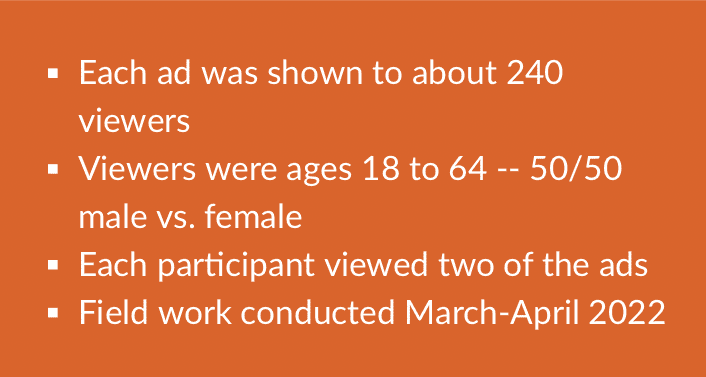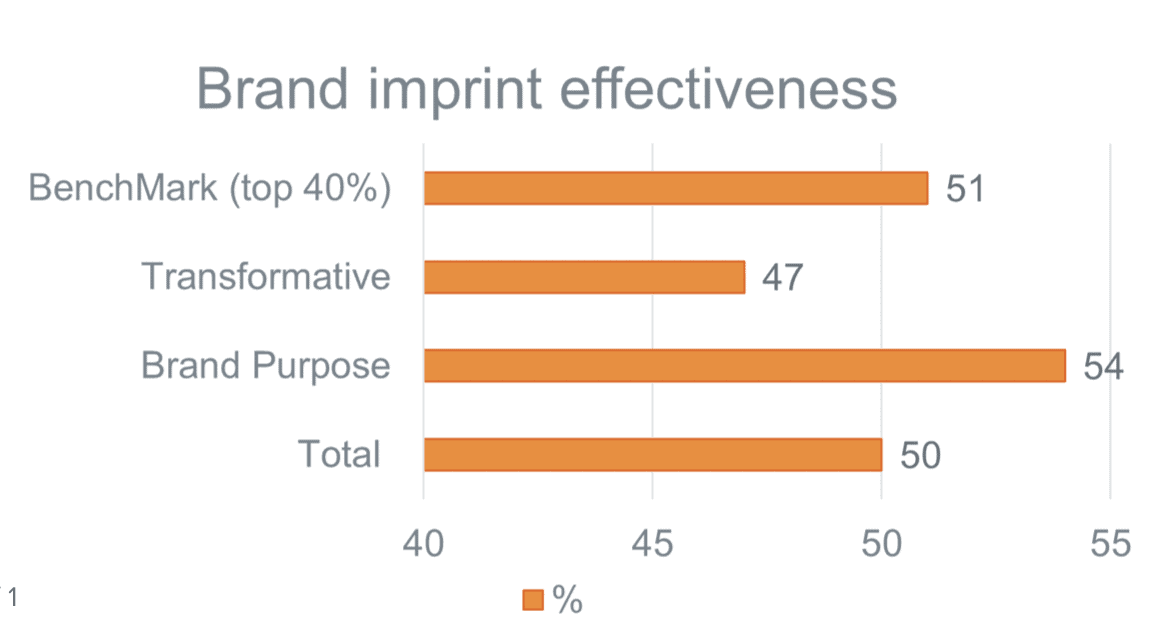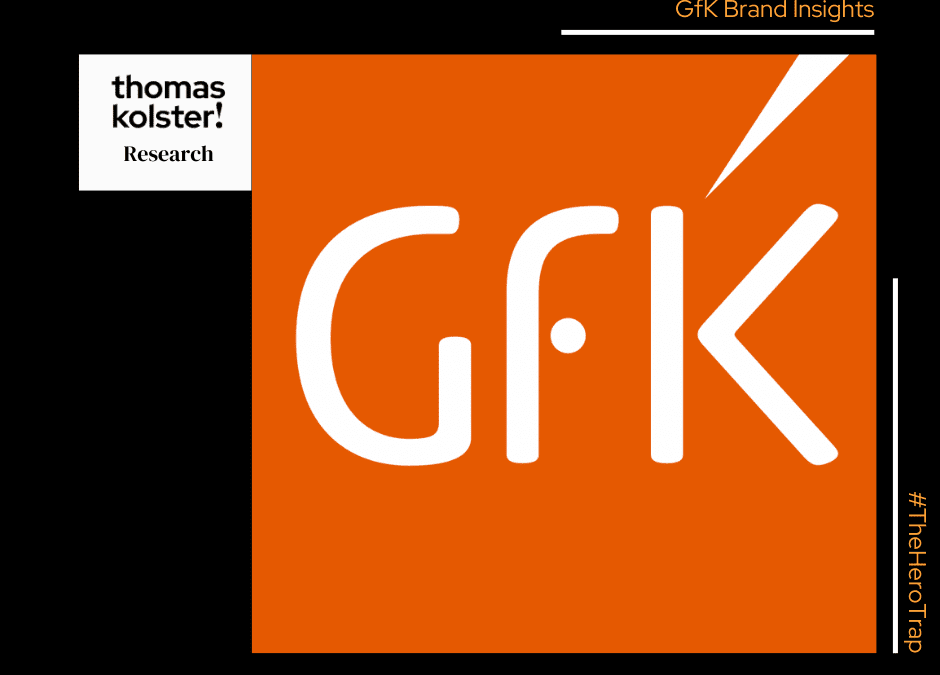Yeah, you might think the Greta Thunberg-generation are fighting with banners in hand when your brand tries to rally the purpose movement? The second part of our research together with research agency GfK showcase it’s actually older generation that pays more attention to those purpose ads. Understand your generations right or your purpose communication will fail. The study compared 20 brand purpose ads and 20 transformative ads from major brands on metrics relating to brand awareness and imprint, as well as a battery of emotional and intellectual reactions – from “is making my life better” to “inspires me to be part of the change.”
The study shows that Generation X (ages 41 to 60) is most likely to notice and then continue watching a purpose ad – followed closely by Baby Boomers (ages 61+). (See Chart 1.) Generation Z (18 to 24) and Millennials (25 to 40) scored much lower on these basic metrics of attention to the ads.

Another interesting point, I’ve been touting for a while is a much-needed shift away from #TheHeroTrap. The study shows that transformational ads – those that focus on consumer achievements and empowerment, rather than the brand’s own heroism – had a stronger emotional impact across a number of key questions. (See Table 2.) Together with GfK we found clearly significant differences on statements such as “makes me feel empowered by the message” and “message sets it apart from others in the same category.”

The Updated Study
It is not even radical to suggest that purpose is the new pillar of brand building. Just a few years ago, “good works” and “social responsibility” were like the vegetables corporations were forced to eat once or twice a year – a well-meaning press release here, a charity donation there, with little engagement from the company as a whole.
But today, we live in a new brand universe. Climate change has brought sustainability into sharp focus as an urgent priority, not just a nice-to-have. The tragic deaths of George Floyd and many others have transformed social justice into a mainstream priority, something brands of every kind simply cannot ignore. Most recently, we are even seeing companies take a stand on abortion rights – a topic once deemed too hot to handle for even the most progressive brands.
The truth is that what a brand “believes” and how it acts in the world are now essential to acceptance and success.
GfK research has shown that enhancing a brand’s ability to be loved, relevant and meaningful – being a catalyst for creating change – will also boost its capacity to build long-term value, or equity. And while a few brands have CSR baked into their core identities, most are still struggling to find their ways with a variety of purpose-driven messages and creatives.
These campaigns may have the best of intentions, but they also represent major brand investments and need to be measured against some standard. If they are trying to enact global change – and build brand loyalty in the process – how are they doing? Surprisingly, purpose ads have rarely been compared, side by side, for actual effect. Is all of this good feeling actually moving the needle with consumers – in terms of awareness, engagement, and motivation to take real action?

A look at transformational branding
For this research, GfK partnered with myself and Goodvertising Agency to explore the good, the bad, and the ambivalent in purpose advertising. In his book The Hero Trap, I argue for a new breed of purpose marketing – one driven less by glorification of the brand itself (“The Hero”) and more by inspiration and empowerment of consumers themselves. I have labeled this new approach to purpose transformational branding.
The marketing pressure on purpose to evolve is clear … It’s a move from a transactional relationship – “Believe in us as a company to bring about change” – to a transformational one – “Believe in your own ability …”
To put some finite findings around purpose ad effectiveness, then, GfK and Goodvertising identified 20 creatives in two broad purpose categories:
Traditional Purpose – focusing on good works by the brand itself, with various degrees of transparent branding (even unabashed “hyping” at times). These ads are somewhat more likely to contain brand cues throughout the story.
Transformational – ads that celebrate the consumer as hero, telling what they can do or have done, and treating the brand itself as a supporting player.
While some of the ads measured fall clearly into one category or the other, the distinction is not always crystal clear. But we have called out some of the clearest examples of each type, as well as looking at purpose advertising overall. Our goal – to establish a knowledge base to help clients navigate this new communication path, and to identify potential new ways to think and talk about purpose.

To evaluate the 20 ads, we leveraged GfK’s Ad Fit Optimizer (AFO) methodology, a proven and uniquely effective approach that has been adopted by dozens of major brands.
With AFO, we:
- measure unforced exposures to ads in their natural environments (pre-roll)
- capture engagement through behavioral metrics
- define an ad’s ability to Hook and then Hold viewer attention
- AFO’s consistent analytic framework focuses on
“F-I-T”:
- Fascinates – Grabs and keeps attention
- Imprints – Leaves a lasting impression
- Triggers – Motivates direct or indirect responses
Brand purpose ads struggle to break through
Comparing our 20 brand purpose ads to a benchmark for all video creatives, the purpose ads had a significantly harder time grabbing viewers’ attention and holding it. This held true for transformational and traditional ads alike.

How to activate: Use a multimedia program to reinforce your purpose and involve your targets. Adding shorter, more active communication will enhance breakthrough and better engage younger viewers who are used to shorter sound bites and communication strategies. Many of the advertising stories may not be immediately linked to brands in consumers’ minds. While this is not cognitive dissonance per se, it will take time and reinforcement for associations
Success Stories
Dove’s “Reverse Selfie” is a poignant take on issues facing young tween girls that also fits perfectly with the essence of Dove brands. The message reaches every age group and is one of the best-performing ads tested.
H&M’s “Conscious Exclusive” spot is simple, well executed branding and a clear message.
Patagonia’s “We are all screwed” had the ability to hold onto its audience, and the issue resonates and is a fit with the brand.
FedEx “Delivering for Earth” provides a very clear and well branded message fitting in with what the brand does and tackling exactly what it can take on as its purpose (carbon neutrality).
Transformational ads are particularly effective at getting their messages across
Success Stories
Dove’s “Reverse Selfie” and Patagonia’s “We are all screwed” – while very different creative executions – are also better at message clarity. Again, they are both known for the very purpose and transformation they ask of their consumers.
“The Hiring Chain” is focused on the upbeat story of someone who hires, and inspires another to hire, and so on. The main creative elements reinforce the intended behavior change.
When it comes to message clarity, the purpose creatives we tested significantly outperformed the general industry benchmark – with transformational creatives especially strong. Nearly half (48%) of transformational ad viewers reported that the message was clear, compared to just one-third (33%) for all ads. Some simple brand purpose ads do a solid job at communicating clearly, but creatives varied widely in their focus on specific messages and actions. There are only a few ads that put the most compelling attention on what to do or what has been done.
How to activate: Ensure the most memorable creative elements reinforce the action the brand is inspiring to change; this is a core trait of transformational campaigns and suggests a potentially powerful alternative to traditional messaging.
Being clear and to the point is especially important for purpose ads – and it is also essential to ensure that the brand fits with the message and is well woven into the story.
Success Stories
Dove’s “Reverse Selfie” and Patagonia’s “We are all screwed” – while very different creative executions – are also better at message clarity. Again, they are both known for the very purpose and transformation they ask of their consumers.
“The Hiring Chain” is focused on the upbeat story of someone who hires, and inspires another to hire, and so on. The main creative elements reinforce the intended behavior change.
Don’t expect a brand’s new purpose commitments to resonate with consumers immediately
Success Stories
- Pepsi Max’s “Nothing Tastes Better” is short and to the point.
- H&M’s “Conscious Exclusive” is simply well branded.
- Colgate’s “Power of a Smile” 15-second spot tugged at emotions while clearly being about the brand.

On traditional branding metrics, such as recall, the purpose ads we measured were essentially identical to our benchmark standards. Striking the right balance between brand and cause in purpose ads is a challenge – but some ads managed to succeed on both counts.
Branding is actually stronger for traditional purpose ads than for transformative. Our hypothesis is that the definition of a transformative approach may take viewers a little more time/viewings to understand how they – along with the brand – can be part of the story. Because viewers are more accustomed to messages in traditional purpose ads, they are easier to grasp. In addition, branding cues are somewhat more frequent in traditional purpose ads.
On traditional branding metrics, such as recall, the purpose ads we measured were essentially identical to our benchmark standards. Striking the right balance between brand and cause in purpose ads is a challenge – but some ads managed to succeed on both counts.
Branding is actually stronger for traditional purpose ads than for transformative. Our hypothesis is that the definition of a transformative approach may take viewers a little more time/viewings to understand how they – along with the brand – can be part of the story. Because viewers are more accustomed to messages in traditional purpose ads, they are easier to grasp. In addition, branding cues are somewhat more frequent in traditional purpose ads.
How to activate: There is a very strong correlation between frequency of brand visuals/mentions or mnemonic devices and branded recall. The brand needs to be part of the story – but we also want to put causes and compassion front and center.
Striking the right balance is essential, and brands cannot expect consumers to fully absorb their new purpose commitments overnight.
What we learned…
- It’s time for new approaches to purpose branding and messaging.
To break through in today’s cluttered environment requires innovation and imagination – as we see in the new transformational category.
- To help accelerate the connection between brand and purpose be clear, focused, and brief.
Use multiple mediums – and do not expect instant results.
- Finding the right balance between brand and cause is essential.
Great ads and great fit between purpose and brand do just that. Weave your brand into the story in ways that make sense and support your overall message. Brand overkill stands out even more in a purpose context, but you still need to claim your space.
We are more than happy to talk about what this means for your communication – do reach out – or why not go download the study and explore some of the many other interesting findings. David Stanton #GfK #Research #PurposeMonitor#PostPurpose #Advertising #Branding
More here: https://lnkd.in/e-Vys9Tc

